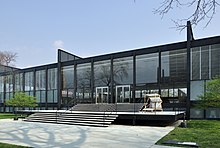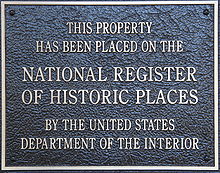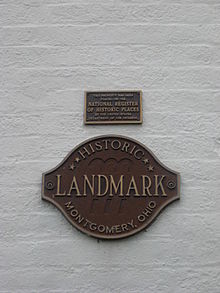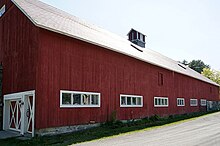How To Cite A National Register Nomination
| Bureau overview | |
|---|---|
| Formed | 1966 (1966) |
| Jurisdiction | The states |
| Annual budget | $sixteen.8 million (2018) |
| Agency executive |
|
| Parent department | National Park Service |
| Website | www |
The National Annals of Celebrated Places (NRHP) is the U.s.a. federal government's official list of districts, sites, buildings, structures and objects deemed worthy of preservation for their historical significance. A property listed in the National Register, or located within a National Register Historic District, may authorize for tax incentives derived from the total value of expenses incurred in preserving the property.
The passage of the National Historic Preservation Human activity (NHPA) in 1966 established the National Annals and the process for adding properties to it. Of the more than than one and a half 1000000 properties on the National Register, 95,000 are listed individually. The remainder are contributing resource within historic districts.
For most of its history, the National Register has been administered by the National Park Service (NPS), an agency within the United States Department of the Interior. Its goals are to help property owners and interest groups, such as the National Trust for Historic Preservation, too equally to coordinate, identify and protect historic sites in the United States. While National Register listings are mostly symbolic, their recognition of significance provides some financial incentive to owners of listed properties. Protection of the belongings is not guaranteed. During the nomination process, the property is evaluated in terms of the 4 criteria for inclusion on the National Register of Historic Places. The application of those criteria has been the subject of criticism by academics of history and preservation, as well as the public and politicians.
Occasionally, historic sites exterior the country proper, but associated with the U.s.a. (such every bit the American Legation in Tangier) are likewise listed. Backdrop tin be nominated in a variety of forms, including individual properties, historic districts and multiple holding submissions (MPS). The Register categorizes general listings into one of five types of properties: district, site, structure, building or object.
National Register Historic Districts are divers geographical areas consisting of contributing and non-contributing properties. Some properties are added automatically to the National Annals when they become administered by the National Park Service. These include National Historic Landmarks (NHL), National Celebrated Sites (NHS), National Historical Parks, National Military Parks, National Memorials and some National Monuments. (Federal properties tin can exist proclaimed National Monuments nether the Antiquities Human activity because of either their historical or natural significance. They are managed by multiple agencies. Only monuments that are celebrated in character and managed by the National Park Service are listed administratively in the National Register.)
History [edit]


On October 15, 1966, the Celebrated Preservation Act created the National Register of Historic Places and the corresponding State Celebrated Preservation Offices (SHPO).[3] Initially, the National Register consisted of the National Celebrated Landmarks designated before the Register's creation, equally well as whatever other historic sites in the National Park organisation.[4] Approving of the deed, which was amended in 1980 and 1992, represented the get-go time the United States had a wide-based historic preservation policy.[iii] [5] The 1966 human activity required those agencies to piece of work in conjunction with the SHPO and an contained federal agency, the Advisory Council on Historic Preservation (ACHP), to face agin furnishings of federal activities on celebrated preservation.[vi]

To administer the newly created National Register of Historic Places, the National Park Service of the U.S. Department of the Interior, with director George B. Hartzog Jr., established an administrative division named the Office of Archaeology and Historic Preservation (OAHP).[half dozen] [7] Hartzog charged OAHP with creating the National Register program mandated by the 1966 law. Ernest Connally was the Office's first manager. Within OAHP new divisions were created to bargain with the National Register. The partition administered several existing programs, including the Historic Sites Survey and the Historic American Buildings Survey, equally well as the new National Annals and Celebrated Preservation Fund.[half-dozen]
The first official Keeper of the Register was William J. Murtagh, an architectural historian.[4] During the Register's earliest years in the tardily 1960s and early 1970s, organisation was lax and SHPOs were pocket-size, understaffed and underfunded.[seven] Withal, funds were still existence supplied for the Historic Preservation Fund to provide matching grants-in-aid to listed holding owners, first for business firm museums and institutional buildings, merely later for commercial structures equally well.[6]
A few years later in 1979, the NPS history programs affiliated with both the U.South. National Parks system and the National Register were categorized formally into ii "Banana Directorates". Established were the Assistant Directorate for Archeology and Celebrated Preservation and the Assistant Advisers for Park Historic Preservation. From 1978 until 1981, the chief agency for the National Annals was the Heritage Conservation and Recreation Service (HCRS) of the Usa Section of the Interior.[9]
In February 1983, the 2 assistant directorates were merged to promote efficiency and recognize the interdependency of their programs. Jerry Fifty. Rogers was selected to direct this newly merged associate directorate. He was described equally a skilled administrator, who was sensitive to the need for the NPS to piece of work with SHPOs, academia and local governments.
Although not described in item in the 1966 human action, SHPOs eventually became integral to the process of listing properties on the National Annals. The 1980 amendments of the 1966 law further divers the responsibilities of SHPOs apropos the National Register.[9] Several 1992 amendments of the NHPA added a category to the National Register, known as Traditional Cultural Backdrop: those properties associated with Native American or Hawaiian groups.[5]
The National Annals of Celebrated Places has grown considerably from its legislative origins in 1966. In 1986, citizens and groups nominated iii,623 separate properties, sites and districts for inclusion on the National Register, a total of 75,000 separate properties.[9] Of the more than than ane and a one-half million properties on the National Register, 95,000 are listed individually. Others are listed as contributing members inside historic districts.[6] [10]
Nomination procedure [edit]
It is hereby declared to be the policy of the United States Authorities that special effort should be made to preserve the natural beauty of the countryside and public park and recreation lands, wild animals and waterfowl refuges, and historic sites.[11]
—(49 USC 303)
Any individual tin set a National Annals nomination, although historians and celebrated preservation consultants often are employed for this piece of work. The nomination consists of a standard registration class (NPS 10-900) and contains basic information most a property's physical appearance and the blazon of significance embodied in the building, structure, object, site, or commune.[12]
The State Historic Preservation Office (SHPO) receives National Annals nominations and provides feedback to the nominating individual or group. Afterward preliminary review, the SHPO sends each nomination to the country's historic review commission, which then recommends whether the Country Historic Preservation Officeholder should transport the nomination to the Keeper of the National Register. For whatsoever not-Federally owned property, only the State Historic Preservation Officer may officially nominate a belongings for inclusion in the National Register. After the nomination is recommended for listing in the National Register by the SHPO, the nomination is sent to the National Park Service, which approves or denies the nomination.
If approved, the property is entered officially past the Keeper of the National Register into the National Register of Celebrated Places.[12] Belongings owners are notified of the nomination during the review by the SHPO and country'due south celebrated review commission. If an possessor objects to a nomination of private belongings, or in the case of a historic district, a majority of owners, then the belongings cannot exist listed in the National Register of Historic Places.[12]
Criteria [edit]

For a belongings to be eligible for the National Register, it must come across at least one of the 4 National Register main criteria.[13] Information about architectural styles, association with various aspects of social history and commerce and ownership are all integral parts of the nomination. Each nomination contains a narrative department that provides a detailed concrete description of the property and justifies why information technology is significant historically with regard either to local, state, or national history. The four National Register of Celebrated Places criteria are the following.
- Criterion A, "Event", the holding must make a contribution to the major blueprint of American history.
- Benchmark B, "Person", is associated with meaning people of the American past.
- Criterion C, "Blueprint/Construction", concerns the distinctive characteristics of the edifice by its architecture and construction, including having slap-up artistic value or being the work of a master.
- Criterion D, "Information potential", is satisfied if the property has yielded or may be likely to yield information important to prehistory or history.[12]
The criteria are applied differently for different types of properties; for instance, maritime properties accept awarding guidelines different from those of buildings.[13]
Exclusions [edit]
There are specific instances where properties unremarkably do non merit list in the National Register. Every bit a general rule, cemeteries, birthplaces, graves of historical figures, properties owned by religious institutions or used for religious purposes, moved structures, reconstructed celebrated buildings, commemorative properties and properties that have achieved significance during the last l years are non qualified for listing on the Annals.[12] At that place are, however, exceptions to all the preceding; mitigating circumstances let properties classified in one of those groups to be included.[12]
Backdrop listed [edit]

A typical plaque found on properties listed in the National Register of Historic Places

An alternate series of plaques. Buildings on the National Annals are often listed in local celebrated societies likewise.
A listing on the National Register of Historic Places is governmental acknowledgment of a celebrated district, site, edifice, or property. Nonetheless, the Register is more often than not "an honorary status with some federal financial incentives".[14] The National Register of Historic Places automatically includes all National Historic Landmarks likewise every bit all celebrated areas administered by the National Park Service.[3]
Landmarks such as these include National Celebrated Sites (NHS), National Historical Parks, National Armed forces Parks/Battlefields, National Memorials and some National Monuments. Occasionally, historic sites exterior the United States borders, just associated with the United States, such as the American Legation in Tangier, Morocco, also are listed.[15]
Listing in the National Register does not restrict individual property owners from the use of their property.[sixteen]
Some states and municipalities, withal, may take laws that get effective when a property is listed in the National Register. If federal coin or a federal permitting procedure is involved, Section 106 of the National Historic Preservation Act of 1966 is invoked. Section 106 requires the federal agency involved to assess the effect of its deportment on celebrated resources.[17] Statutorily, the Advisory Council on Celebrated Preservation (ACHP) has the most significant function by Section 106 of the National Historic Preservation Act. The department requires that the director of whatever federal agency with direct or indirect jurisdiction of a project that may affect a property listed or determined eligible for list in the National Register of Historic Places must first report to the Informational Quango. The manager of said agency is required to "take into account the issue of the undertaking" on the National Register property, also as to afford the ACHP a reasonable opportunity to comment.[18]
While Section 106 does not mandate explicitly that any federal bureau director accept the advice of the ACHP, their advice has a practical influence, especially given the statutory obligations of the NHPA that require federal agencies to "have into account the outcome of the undertaking".[17] [18]
In cases where the ACHP determines federal activity will have an "adverse effect" on historic backdrop, mitigation is sought. Typically, a Memorandum of Agreement (MOA) is created past which the involved parties agree to a particular plan. Many states take laws similar to Department 106.[17] In contrast to conditions relating to a federally designated historic district, municipal ordinances governing local celebrated districts often restrict sure kinds of changes to properties. Thus, they may protect the property more than a National Register listing does.[19]
The Department of Transportation Act, passed on October fifteen, 1966, the aforementioned solar day as the National Historic Preservation Deed, included provisions that addressed historic preservation. The DOT Human activity is much more than general than Department 106 NHPA in that it refers to properties other than those listed in the Register.[18]
The more than general language has allowed more properties and parklands to savor status as protected areas past this legislation, a policy developed early in its history. The United states of america Supreme Courtroom ruled in the 1971 case Citizens to Preserve Overton Park 5. Volpe that parklands could have the same protected status every bit "historic sites".[18]
-

-

Walden Pond is an instance of a natural site listed on the NRHP.
Multiple property submission [edit]

A multiple property submission (MPS) is a thematic group listing of the National Annals of Historic Places that consists of related properties that share a common theme and can be submitted equally a group. Multiple holding submissions must satisfy sure bones criteria for the group of properties to be included in the National Register.
The process begins with the multiple property documentation class which acts as a cover document rather than the nomination to the National Register of Historic Places. The purpose of the documentation grade is to establish the basis of eligibility for related properties. The data of the multiple property documentation class tin be used to nominate and register related historic backdrop simultaneously, or to establish criteria for backdrop that may be nominated in the hereafter. Thus, additions to an MPS can occur over time.
The nomination of private properties in an MPS is accomplished in the same manner as other nominations. The proper name of the "thematic grouping" denotes the historical theme of the properties. Information technology is considered the "multiple holding listing". Once an individual belongings or a grouping of properties is nominated and listed in the National Register, the multiple holding documentation course, combined with the private National Annals of Celebrated Places nomination forms, constitute a multiple property submission.[xx]
Examples of MPS include the Lee County Multiple Property Submission, the Warehouses in Omaha, the Boundary Markers of the Original District of Columbia and the Illinois Carnegie Libraries. Before the term "Multiple Property Submission" was introduced in 1984, such listings were known as "Thematic Resource", such equally the Operating Rider Railroad Stations Thematic Resources, or "Multiple Resources Areas".[21]
Types of properties [edit]

Example of a barn on the National Register of Historic Places; Cow Barn; Enfield Shaker Village, New Hampshire; built 1854.[22]
Listed properties are by and large in ane of five broad categories, although there are special considerations for other types of backdrop that in any one, or into more than specialized subcategories. The five general categories for National Register properties are: building, structure, site, commune and object.[13] In improver, historic districts consist of contributing and not-contributing properties.
Buildings, as defined by the National Register, are distinguished in the traditional sense. Examples include a business firm, barn, hotel, church, or like structure. They are created primarily to shelter human activity. The term edifice, as in outbuilding, can exist used to refer to historically and functionally related units, such every bit a courthouse and a jail or a barn and a business firm.[thirteen]
Structures differ from buildings in that they are functional constructions meant to be used for purposes other than sheltering human activity. Examples include an aircraft, a grain elevator, a gazebo and a bridge.
Objects are normally artistic in nature, or pocket-size in scale compared to structures and buildings. Although objects may be movable, they are by and large associated with a specific setting or surround. Examples of objects include monuments, sculptures and fountains.
Sites are the locations of significant events, which can be prehistoric or historic in nature and stand for activities or buildings (standing, ruined, or vanished). When sites are listed, it is the locations themselves that are of historical involvement. They possess cultural or archaeological value regardless of the value of whatever structures that currently be at the locations. Examples of types of sites include shipwrecks, battlefields, campsites, natural features and stone shelters.[13]
Celebrated districts possess a concentration, clan, or continuity of the other four types of backdrop. Objects, structures, buildings and sites in a celebrated district are united historically or aesthetically, either by choice or by the nature of their development.[xiii]
There are several other different types of historic preservation associated with the backdrop of the National Register of Historic Places that cannot be classified as either simple buildings and historic districts. Through the National Park Service, the National Register of Celebrated Places publishes a series of bulletins designed to aid in evaluating and applying the criteria for evaluation of different types of properties.[xiii] Although the criteria are always the same, the manner they are applied may differ slightly, depending upon the type of property involved. The National Register bulletins describe the awarding of the criteria for aids to navigation, celebrated battlefields, archaeological sites, aviation properties, cemeteries and burial places, celebrated designed landscapes, mining sites, mail offices, backdrop associated with meaning persons, properties achieving significance inside the last fifty years, rural celebrated landscapes, traditional cultural backdrop and vessels and shipwrecks.[xiii]
Belongings owner incentives [edit]

Properties are not protected in whatever strict sense by the Federal listing. States and local zoning bodies may or may non choose to protect listed historic places. Indirect protection is possible, past state and local regulations on the evolution of National Register properties and by taxation incentives. By contrast, the state of Colorado, for case, does not set any limits on owners of National Annals properties. Run across [23]
Until 1976, federal tax incentives were virtually not-real for buildings on the National Annals. Before 1976 the federal tax lawmaking favored new construction rather than the reuse of existing, sometimes historical, structures.[vi] In 1976, the tax lawmaking was altered to provide taxation incentives that promote the preservation of income-producing celebrated properties. The National Park Service was given the responsibility to ensure that only rehabilitations that preserved the historic character of a building would qualify for federal revenue enhancement incentives. A qualifying rehabilitation is one that the NPS deems consistent with the Secretary of the Interior's Standards for Rehabilitation.[24] Properties and sites listed in the Register, equally well as those located in and contributing to the period of significance of National Annals Historic Districts, became eligible for the federal taxation benefits.[half dozen]
Owners of income-producing properties listed individually in the National Register of Historic Places or of properties that are contributing resource within a National Register Historic Commune may exist eligible for a twenty% investment tax credit for the rehabilitation of the historic structure. The rehabilitation may be of a commercial, industrial, or residential property, for rentals.[16] The revenue enhancement incentives programme is operated past the Federal Historic Preservation Tax Incentives program, which is managed jointly by the National Park Service, individual Country Historic Preservation Offices and the Internal Acquirement Service.[25]
Some property owners may also qualify for grants, like the at present-defunct Save America'due south Treasures grants, which apply specifically to properties entered in the Register with national significance or designated equally National Historic Landmarks.[26] [27]
The NHPA did not distinguish betwixt backdrop listed in the National Register of Historic Places and those designated as National Historic Landmarks apropos qualification for tax incentives or grants. This was deliberate, as the authors of the human action had learned from experience that distinguishing between categories of significance for such incentives caused the lowest category to go expendable.[4] Essentially, this made the Landmarks a kind of "award roll" of the most significant properties of the National Register of Historic Places.[4]
Contempo by [edit]

fifty-year dominion [edit]
In American historic preservation, the 50-year rule is the by and large held conventionalities that a property must be at to the lowest degree 50 years old to be listed in the National Register of Historic Places.[28] Really, there is no difficult dominion. As stated past John H. Sprinkle Jr., deputy managing director of the Federal Preservation Constitute, "this 'rule' is only an exception to the criteria that shape listings within the National Register of Celebrated Places. Of the eight 'exceptions' [or criteria considerations], Consideration G, for properties that have achieved significance inside the by fifty years, is probably the best-known, yet likewise misunderstood preservation principle in America."[28] Each year, a new group of resources crosses the 50-yr threshold. The preservation of these "underage" resources has gained attention in recent years.
Limitations [edit]

As of 1999, there have been 982 properties removed from the Annals, nigh often due to being destroyed.[thirty] Among the properties that were demolished or otherwise destroyed after their listing are the Jobbers Canyon Historic District in Omaha, Nebraska (listed in 1979, demolished in 1989),[31] [32] Pan-Pacific Auditorium in Los Angeles, California (listed in 1978, destroyed in a fire in 1989),[33] Palace Amusements in Asbury Park, New Jersey (listed in 2000, demolished in 2004),[34] The Balinese Room in Galveston, Texas (listed in 1997, destroyed past Hurricane Ike in 2008),[35] vii of the ix buildings included in the Academy of Connecticut Historic District in Storrs, Connecticut (listed in 1989, demolished in 2017),[36] and the Terrell Jacobs Circus Winter Quarters in Peru, Indiana (listed in 2012, demolished in 2021).[37]
See besides [edit]
- Historic district
- Listed building, the UK equivalent
- National Heritage Expanse
- Register of Culturally Significant Property
- U.s. National Register of Historic Places listings
- Listing of National Historic Landmarks by state
- List of National Memorials of the United States
- List of threatened historic sites in the Usa
- Listing of African-American historic places
- List of university and college buildings on the National Register of Historic Places
- List of jails and prisons on the National Register of Historic Places
- List of heritage registers worldwide
References [edit]
- ^ "National Annals Information System". National Register of Historic Places. National Park Service. July 9, 2010.
- ^ "National Park Service Directors and Advisers, Historic Listing of National Park Service Officials, National Park Service Data Store (IRMA), Official site. Retrieved February 23, 2022.
- ^ a b c "National Celebrated Preservation Act of 1966, Public Law 102–575, National Conference of State Historic Preservation Officers, Official site. Retrieved February 23, 2022.
- ^ a b c d Mackintosh, Barry. "The Historic Sites Survey and National Historic Landmarks Program: A History, National Park Service Information Store (IRMA), Official site. Retrieved February 23, 2022.
- ^ a b Ferguson, T. J. "Native Americans and the Practice of Archaeology Archived February 6, 2017, at the Wayback Machine" (JSTOR), Annual Review of Anthropology, Vol. 25. (1996), pp. 63–79. Retrieved March 23, 2007.
- ^ a b c d e f g Fisher, Charles E. (1998). "Promoting the Preservation of Historic Buildings: Historic Preservation Policy in the United States". APT Bulletin. 29 (3/4): vii–11. doi:x.2307/1504604. JSTOR 1504604.
- ^ a b Scarpino, Philip 5. "Planning for Preservation: A Look at the Federal-Country Historic Preservation Program, 1966–1986 (in The Intergovernmental Politics of Preservation) Archived Nov 11, 2018, at the Wayback Motorcar" (JSTOR), The Public Historian, Vol. fourteen, No. 2. (Bound, 1992), pp. 49–66. Retrieved March 21, 2007.
- ^ a b c Hertfelder, Eric. "The National Park Service and Historic Preservation: Historic Preservation across Smokey the Conduct (in Commentary: How Well Is the National Park Service Doing?) Archived November eleven, 2018, at the Wayback Machine" (JSTOR), The Public Historian, Vol. 9, No. 2, The National Park Service and Historic Preservation. (Jump, 1987), pp. 135–142. Retrieved March 21, 2007.
- ^ "National Register Database," National Annals of Celebrated Places, Official site. Retrieved February 23, 2022.
- ^ "The Department of Transportation Act of 1966, Cornell Law School Legal Information Found, Official site. Retrieved February 23, 2022.
- ^ a b c d e f "National Register Message xvi: How to Complete the National Register Form, Chapter viii," National Annals of Historic Places, Official site. Retrieved February 23, 2022.
- ^ a b c d e f g h "National Register Bulletin 15: How to Use the National Annals Criteria for Evaluation," National Annals of Celebrated Places, Official site. Retrieved February 23, 2022.
- ^ "Working on the Past: In Local Historic Districts," Technical Preservation Services, Official site. Retrieved Feb 23, 2022.
- ^ "Listing of NHLs," National Historic Landmarks Program, Official site. Retrieved February 23, 2022.
- ^ a b "Results of listing and Owner information," National Register of Historic Places, Official site. Retrieved February 23, 2022.
- ^ a b c "National Historic Preservation Act, Department 106," Tribal Preservation Program, Official site. Retrieved February 23, 2022.
- ^ a b c d Greyness, Oscar S. "The Response of Federal Legislation to Historic Preservation Archived Dec 22, 2018, at the Wayback Machine" (JSTOR), Police and Contemporary Problems, Vol. 36, No. three, Historic Preservation. (Summertime, 1971), pp. 314–328. Retrieved March 21, 2007.
- ^ "Federal, Land and Local Celebrated Districts," Technical Preservation Services, Official site. Retrieved Feb 23, 2022.
- ^ "Bulletin sixteen Part B: How to Complete the National Register Multiple Holding Documentation Form," National Register of Celebrated Places, Official site. Retrieved Feb 23, 2022.
- ^ "Search for Multiple Property Submission (MPS) Covers," National Annals of Historic Places", Official site. Retrieved February 23, 2022.
- ^ "Cow Barn". Enfield Shaker Museum . Retrieved March fourteen, 2022.
- ^ ""National and land registers", at Colorado Office of Archeology & Historic Preservation," History Colorado, Official site. Retrieved February 23, 2022.
- ^ "Rehabiliation Standards and Guidelines—Technical Preservation Services, National Park Service". NPS.gov Homepage (U.S. National Park Service). Archived from the original on December 18, 2017. Retrieved Nov 16, 2017.
- ^ "Historic Preservation Revenue enhancement Incentives", Technical Preservation Services, National Park Service, Official site. Retrieved February 23, 2022.
- ^ "Save America's Treasures Grants" Historic Preservation Fund National Park Service, Official Site. Retrieved February 23, 2022.
- ^ "Save America's Treasures". National Trust for Celebrated Preservation. Archived from the original on February nineteen, 2013. Retrieved March 1, 2013.
- ^ a b Sprinkle, John H., Jr. (Leap 2007). ""Of Exceptional Importance": The Origins of the "Fifty-Yr Dominion" in Historic Preservation". The Public Historian. 29 (two): 81–103. doi:10.1525/tph.2007.29.2.81. JSTOR 10.1525/tph.2007.29.2.81. Archived from the original on April 17, 2021. Retrieved Dec 3, 2020.
- ^ Fallows, James (June 21, 2019). "Our Towns: How Danville Has Avoided Omaha'due south Mistake - The Atlantic". www.theatlantic.com. Archived from the original on June two, 2021. Retrieved May 31, 2021.
- ^ Church sues over historic site Archived Baronial 6, 2012, at the Wayback Car, Caren Burmeister, Jacksonville Times-Matrimony, iii/23/99. Retrieved vii/8/11.
- ^ Gratz, R.B. (1996) Living City: How America's Cities Are Existence Revitalized past Thinking Small in a Large Way. John Wiley and Sons. p. 5.
- ^ National Trust for Historic Preservation and Zagars, J. (1997) Preservation Xanthous Pages: The Complete Information Source for Homeowners, Communities, and Professionals. John Wiley and Sons. p.lxxx.
- ^ "The L.A. architecture landmark — abased, trashed and left to burn". Los Angeles Times. May 24, 2019. Archived from the original on May 25, 2019. Retrieved May 25, 2019.
- ^ Mikle, Jean. "Asbury Park's Tillie is all the same safe". Springfield News-Leader. Archived from the original on May 29, 2020. Retrieved October 1, 2017.
- ^ "Historic Galveston nightclub destroyed". ABC13 Houston. Archived from the original on July 29, 2019. Retrieved July 29, 2019.
- ^ Blair, Russell. "UConn to Demolish Seven of Nine 'Faculty Row' Houses". courant.com. Archived from the original on October two, 2017. Retrieved October i, 2017.
- ^ "Circus barns on National Annals of Historic Places to be demolish". whas11.com. March thirteen, 2021. Archived from the original on April 15, 2021. Retrieved April 6, 2021.
Further reading [edit]
- "Title 36, U.Due south. Code of Federal Regulations". Archived from the original on March 2, 2007.
- "Title 36--Parks, Forests, and Public Property; CHAPTER I--NATIONAL PARK SERVICE, DEPARTMENT OF THE INTERIOR; PART lx--NATIONAL REGISTER OF Historic PLACES". National Archives and Records Assistants. Archived from the original on March 2, 2007. Retrieved April eleven, 2007.
- "National Register Data System". National Register of Historic Places. National Park Service. Retrieved July 11, 2011.
- Shrimpton, Rebecca H., ed. (1997). "How to Apply the National Register Criteria for Evaluation". Washington, D.C.: National Park Service. Retrieved Apr 11, 2007.
National Register Bulletin No. xv
- Sprinkle, John H., Jr. (2014). Crafting Preservation Criteria. The National Register of Historic Places and American Historic Preservation. New York: Routledge.
- Wiley, John (1994). National Register of Historic Places. National Park Service. ISBN0-471-14403-7.
External links [edit]
- world wide web
.nps —National Register of Historic Places.gov /subjects /nationalregister - www
.achp —Informational Council on Historic Preservation.gov
How To Cite A National Register Nomination,
Source: https://en.wikipedia.org/wiki/National_Register_of_Historic_Places
Posted by: monahanroperrin.blogspot.com


0 Response to "How To Cite A National Register Nomination"
Post a Comment